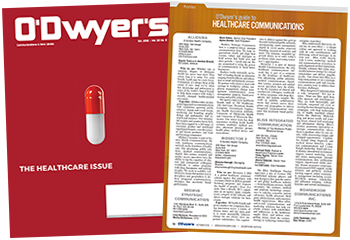 Gil Bashe, Kristie Kuhl and John Bianchi (L to R) co-authored this article.
|
How many screens do you check each day? Smart watch, phone, tablet, laptop and desktop? More? On those screens, how many social sites do you visit and how often? It’s an accepted fact that digital media has changed the communications dynamic and in many more ways than people recognize. For the last several years, communications professionals — on the client and agency side — have treated digital media as a new and growing group of social outlets, a place to post “information billboards” or a wait-and-see mystery. This isn’t the complete picture of the digital media landscape.
Once PR practitioners pursued the “big placement.” But, the New York Times, USA Today or Washington Post feature — still cause for champagne-popping celebration — may have less reach than the story that goes viral on social media with hundreds of shares that add up to millions of influencer connections. The bigger that conversation, the further the reach, drawing in people from the furthest points of the health ecosystem circle-of-influence, creating awareness and driving change.
What’s changing is more than the number and type of social media outlets. Digital technology enables new ways of relating to information, even through what’s still being labeled “traditional” media outlets. Digital communications transform how media works, whether it’s the 200-year-old newspaper or a two-month old blogging platform.
Digital media is inviting readers to become part of the narrative. When the Wall Street Journal publishes an important story geared for the Tuesday print edition — thanks to digital media — readers are already viewing the story online Monday night and talking about it on social media that evening. Opinions are being formed, allies and pundits taking sides and positive and negative comments appearing before the traditional media hit takes center stage. The information exchange game is in motion hours before the paper appears at the corner newsstand.
As communications professionals, we need to tell stories with impact and resonance. We need to move beyond thinking about securing the “big placement” to sparking the “big conversation” that changes mindsets and behaviors. We can no longer look at pursuing traditional media and driving social media conversation as mutually exclusive; they’re parts of the same tactical synthesis. Overall, the story is the spark that drives interest and real engagement. It’s what builds brand awareness and the call-to-action to improve peoples’ lives.
At the heart of this new information environment is an ability to search, access and engage in seconds. SEO and hashtags have the power to connect with topics that are important to our lives with specificity. The smart phone has enabled a 24/7 “I want to know now” engagement mindset. “Now,” takes precedence over complete information. To compete in fast-breaking news environments, top “traditional media” reporters often post initial comments on Twitter and file their longer stories hours later. In the meantime, an army of content bloggers have taken center stage with 280-character Twitter posts, ample length to convey key points and drive social engagement.
To make sure that target audiences assess client news objectively, communication pros must educate their clients to consider how information changes hands. While the Wall Street Journal might be a safe bet to cover a story with objectivity, winning over a social media pundit and seeing their positive tweet may have equal influencer value.
The transformative effects of the digital conversation become apparent in how we research information in every area of our lives, from cooking to politics. The applications of this transformation to how we relate to our personal health are already apparent and are making their mark — and waves — on how consumers consider their right to know and ultimately engage.
“Many consumers expect to own their health journey,” said Michael Heinley, Partner, Health, Finn Partners, and former WebMD VP of Corporate Communication. “Reporters are also consumers and approach access and timing of company information through the lens of: ‘are you worthy of my trust?’ Failure to move quickly is seen as stalling or massaging the facts.”
Likewise, if we consumers go to the doctor’s office for a blood test, we’re no longer content to wait for the paper results. In many cases, they’re available online for our access the same moment that the physician’s office is notified. Here, curiosity — once cited as the danger that “killed the cat” — saves lives. Spurred to action, we may do our own research on the risks and possibilities the results reveal. Though not fully informed on how to translate results into next-steps action, we’re infinitely more aware — albeit anxious — before receiving that physician’s office voice message: “The doctor would like you to come in to discuss your lab tests.”
Digital information is creating healthcare democratization, especially in an age when we rely less and less on a consistent primary care physician and have become our own health historians. As access to information is critical to our families’ wellbeing, we now need our health data at hand. Life-enhancing wearables link to our smart phones and alert us to irregular heart rhythms, adjust diabetes insulin pumps and even fine-tune neuro-implantables to better control Parkinson’s tremor. Digital access is improving lifestyles for people with chronic conditions through cloud-based services that enable people to store and access health records while on the go. Personal investment in digital communications — driving news and social engagement — is the mark of the early adapter.
We no longer wait for tomorrow’s paper when it’s news that’s vital to our pocketbook or medicine chest. Digital media unleashes the “power of now,” and as agencies, we must harness it, or our clients will be left behind, or worse. More importantly, from the moment fast-moving social media reporters share a point of view on their channels, physician leaders, patient advocates and other reporters interact and put their stake in the ground. The sharing of accurate, authentic and compelling editorial and content is how we facilitate a conversation that has influence and causes ripples to spread ever outward, affecting positive change. If we embrace our core mission to make a difference through health communications — to enable people to make informed decisions through access to information — we will find a way to help clients in the highly-regulated health space find better avenues to social and digital platform use. If not, others will tell their versions — accurate or not — of our stories for us.
***
Gil Bashe is Managing Partner, Global Health, Finn Partners @Gil_Bashe. Kristie Kuhl is Senior Partner, Health, Finn Partners @KPCK. John Bianchi is Vice President, Health - Social Impact, Finn Partners @Jnobianchi.



 Finn Partners has recruited cardiologist and noted patient care advocate Richard Levin as chief health affairs counselor, a newly created position.
Finn Partners has recruited cardiologist and noted patient care advocate Richard Levin as chief health affairs counselor, a newly created position. Lo Isidro, senior director at Real Chemistry with more than a decade of strategic communications and PA experience, has joined Narrative Strategies.
Lo Isidro, senior director at Real Chemistry with more than a decade of strategic communications and PA experience, has joined Narrative Strategies. Nelson Fernandez, former North American chair of APCO Worldwide and managing director of Burson-Marsteller, has joined Volunteers in Medicine Berkshires as director of communications and PA.
Nelson Fernandez, former North American chair of APCO Worldwide and managing director of Burson-Marsteller, has joined Volunteers in Medicine Berkshires as director of communications and PA. Lilit Bargar, who was most recently an EVP in the healthcare practice at Weber Shandwick, comes on board at GCI Health as EVP, corporate practice lead.
Lilit Bargar, who was most recently an EVP in the healthcare practice at Weber Shandwick, comes on board at GCI Health as EVP, corporate practice lead.



 Have a comment? Send it to
Have a comment? Send it to 
No comments have been submitted for this story yet.